
|   |

|   |
10th Bhagyachandra National Dance Festival Text & pics: Veejay Sai e-mail: vs.veejaysai@gmail.com November 27, 2014 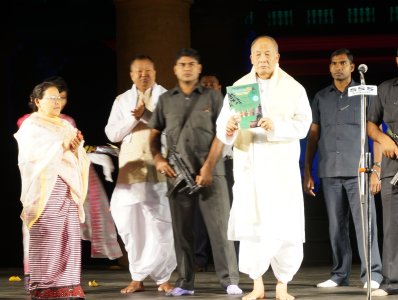 Inauguration A first surge of excitement for a festival that has grown from strength to strength in the last twenty-five years! Thanks to the untiring efforts of artistes like theatre director Ratan Thiyam, Dharmadas Sharma and the efficient staff of the State Art and Culture department that left no stone unturned to make sure every arrangement was in place. For those of you wondering why this festival in Imphal is such a big deal on the arts calendar of the country, you must acquaint yourself with the political disturbances and how they affect artistes’ lives in this part of the country.  Maharaas 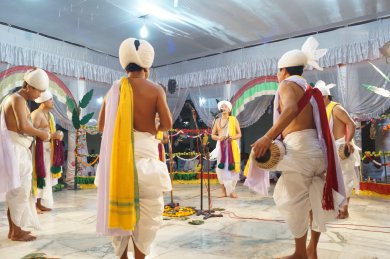 Nupa Pala ritual On the opening evening (Nov 6, 2014) we were treated to a divine Maharaas on the night of Karthik Poornima at the Shri Shri Gopinathji temple on the city’s outskirts in Ningthoukhong in Bishnupur. What a sight! It was like the heavens opened up to see the delicate dancing damsels perform the Maharaas. Scores of devotees dressed in their traditional costume gathered by sunset and as the full moon shone bright over the Imphal skies, a group of Natasankeertan performers purified the air and the space with holy chants of the Nupa Pala ritual. As the fragrance of burning natural resin enveloped the entire venue, we were transported to another world once the elaborate Raas began. One could see various elements of angika and vachika abhinaya at display as the refrain ‘Thaka Tha Tha Thaiyya’ kept the momentum. One evening isn’t enough to study the complex mingling of artistic processes that takes place during the Maharaas. Towards the end as the dancers gave aarti to the dancer pair who played the roles of Radha and Krishna, one could sense the immense bhakthi and commitment of the Manipuri folks that filled the air. 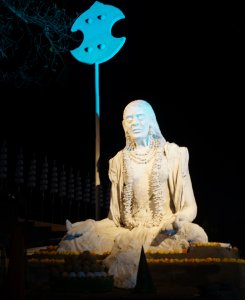 Rajashri Bhagyachandra The next evening at the historic Kangla fort, the Chief Minister of Manipur Shri Okram Ibobi Singh officially inaugurated the festival. The entire makeshift venue was decorated under the expert guidance of Ratan Thiyam and his efficient Chorus Repertory of artistes. A larger than life statue of Rajashri Bhagyachandra welcomed audiences into the venue while a series of traditional Shattras lined up like soldiers guarding the space from behind, overlooking the venue. In front of the stage a small makeshift water body with blooming lotuses and loudly croaking frogs added natural ambience to the scene. 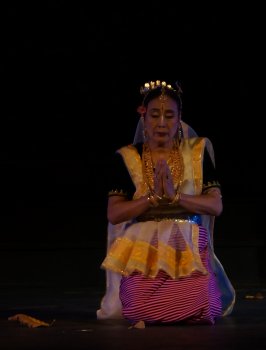 Sabitrisana Devi The first evening opened with a performance by Manipuri dance veteran RK Sabitrisana Devi who is a student of Gurus Atomba Singh and Amobi Singh. Performing excerpts from Jayadeva’s Gita Govindam, one could see how her expertise was demonstrated within the contained artistry of the dance form. A complete contrast of energy was Sujata Mohapatra’s Odissi performance. Her main piece Yugma Dwandwa, a Pallavi set to raag Bagheshree saw her in the best of moods as she danced to Guru Kelucharan Mohapatra’s choreography. The first evening ended with Moirang based Roneld Meitei’s solo. His presentation of Guru Babu Singh’s compositions showed the tandava aspects of Manipuri solo. In his description of the abhisarika nayika, set to the thirty-six beat taal beautifully named as ‘Kokilapriya Taal’, Roneld impressively showed the various moods of the nayika. From her graceful movements compared only to an elephant to those of a swan, the bedecked nayika awaits the arrival of her lover forgetting the weight of all the jewels on her body. Roneld is a promising young talent to look out for in the near future if he works hard to polish his skills. 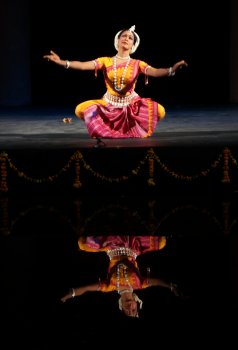 Sujata Mohapatra 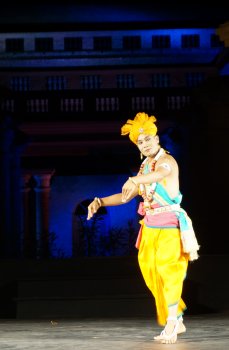 Roneld Meitei The second day’s performances began with Lilavati Devi’s Manipuri dance. A graduate of Chennai’s Kalakshetra, Lilavati performed Haririha Mughda Vadhu choreographed by Guru Amobi Singh. Her own additions of Kavith style Radha Radha Nachat Nachat didn’t fit the scheme of things and felt mismatched. One wonders where this clearly ‘external’ idea was taken from into a soft dance form like Manipuri. The best part of her performance was the wonderful singing by N Priyarani Devi and excellent pung by T Nakuljit. The energy and exuberance of his pung livened the entire performance. This was followed by a Bharatanatyam performance by Bangalore based Sathyanarayana Raju. His ‘Rama Katha’ was a long unwinding show and a hurried fast-forward narration of the epic. After hanging Rama’s bow to a crucifix on the side of the stage, Sathya seemed to run through the length of the story like his audiences were unfamiliar with it. A crisper editing of the show to suit the time would have been more apt for the situation. Karthik Hebbar’s appalling pronunciation of lyrics further spoilt the show. Methil Devika ended the evening with her Mohiniattam performance. Her Krishna Janma was a good mélange of fine-tuned choreography and good music. In what seemed to be time cut off from her existing schedule, Devika’s performance was shortened. The melodious music lingered for a while before the next show began. A complete far cry from this was Vijayawada based Kuchipudi female impersonator Ajay Kumar’s performance. Currently out of form and shape, Ajay put together a poor unimpressive patchwork of dance. His presentation of ‘Ashta Nayika’ was a tedious and lackluster rendering of a catalogue of Nayika bhedas without much involvement. Sobita Devi’s own dance was over-powered by the large orchestra and music she chose to present. While her choreographic works were interesting, over stretching her time made the audiences restless. 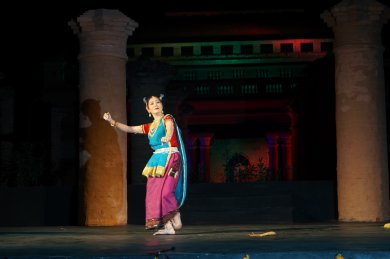 Lilavati Devi 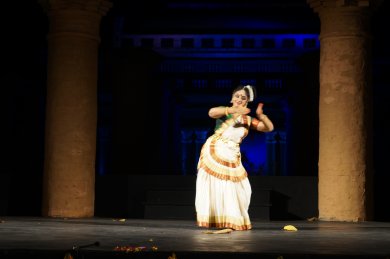 Methil Devika 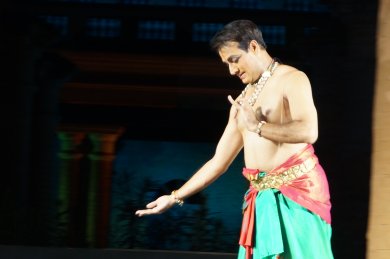 Sathyanarayana Raju 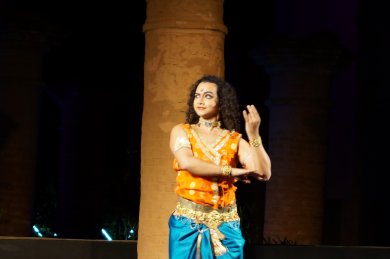 Vishal Krishna  Meernanda Bharthakur 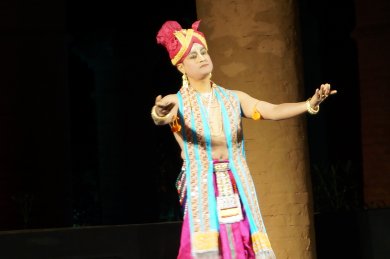 Bighyaneshwar Singh The third and last evening opened with Manipuri by Sarjubala Devi. Describing the beauty of Vishnu, she danced as an excellent orchestra made some memorable music. Once again pung by Nakuljit Singh, sitar by Nelson Sharma, violin by Ibopisak and singing by Gitarani Devi outdid the dance performance itself. This was followed by a highly colourful and commercial presentation by Kathak dancer Vishal Krishna. A barrage of upaj, padhanth, tukdas and whatever else followed, in his attempt to exhibit his virtuosity. What Vishal has is good energy about him but what he lacks is substance and finesse in his dance. His sense of dressing is loud and verges on being tacky and aesthetics takes a backseat when he wears a dramatic crown on his head that doesn’t do much to elevate his performance. If Vishal gets over his exhibitionist methods of dancing, he will go a long way in his career. A contrast from that was Meernanda Bharthakur’s Sattriya performance. Her Devaki Kheda Varnanam, an item choreographed on the birth of Krishna also dealt with a political subtext. Reflecting on the political conflict in Assam and how scores of innocents get victimized in terrorist activities, Meernanda’s dance was thought provoking. However, her dance vocabulary seemed largely borrowed from Bharatanatyam and remained unconvincing in any originality. The fourth and last piece of the festival ended with a Manipuri solo by an out of shape Bighyaneshwar Singh. He neither seemed to put much effort into his dance nor seemed remotely interested to go beyond the regular. This was an anti-climax of sorts. Some excellent musicians like pung expert Nakuljit Singh and Nelson Sharma were discovered during this year’s festival and one is sure they are going to keep the cultural life of Imphal rich with their art. More power to them! So what was very different about this festival from most of the others? The genuine effort taken by the State and arts bodies like JNMDA, Art and Culture dept., to put this together amidst all the political turbulence in that part of the country, is highly commendable. One wished the dancers who were invited to perform also took this platform seriously and presented better. We hope the next festival is taken more serious by the performers, like it is by the organizers and the audiences who throng to the venue. After all, Bhagyachandra Festival remains North East’s most significant and important dance festival of any national importance. Veejay Sai is a writer, editor and a culture critic. |